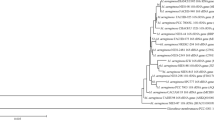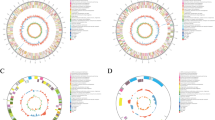Abstract
The marine photosynthetic bacterium Rhodovulum sulfidophilum produces extracellular nucleic acids involved in its flocculation. Previously, we showed that the RNA fraction of these extracellular nucleic acids released into the culture medium contains mainly non-aminoacylated fully mature-sized tRNAs and fragments of 16S and 23S rRNAs. Here, we report the characterization of extracellular DNA itself and its production during cultivation. No differences were detected in nucleotide sequence between the intracellular DNA and extracellular soluble DNA on Southern blotting. Whole intracellular DNA seemed to be released from the cell. The bacterial floc was degraded by deoxyribonuclease or ribonuclease treatment, indicating that at least the extracellular DNA and RNAs in the floc are involved in the maintenance of the floc. When cultivated in nutritionally rich medium, the bacteria formed small flocs and produced large amounts of extracellular DNA, which were solubilized in the medium. In nutritionally poor medium, however, huge flocs of cells appeared and almost no extracellular soluble DNA was observed in the medium. As the floc was degraded by deoxyribonuclease treatment, it seems likely that the extracellular soluble DNA observed in the rich medium may be incorporated into the large floc and play a role in floc maintenance in poor medium. Addition of an inhibitor of quorum sensing, α-cyclodextrin, inhibited huge floc maintenance in the nutritionally poor medium. In the presence of α-cyclodextrin, the floc was rapidly degraded and extracellular soluble DNA production increased.






Similar content being viewed by others
References
Allesen-Holm M, Barken KB, Yang L, Klausen M, Webb JS, Kjelleberg S, Molin S, Givskov M, Tolker-Nielsen T (2006) A characterization of DNA release in Pseudomonas aeruginosa cultures and biofilms. Mol Microbiol 59:1114–1128
Ando T, Suzuki H, Nishimura S, Tanaka T, Hiraishi A, Kikuchi Y (2006) Characterization of extracellular RNAs produced by the marine photosynthetic bacterium Rhodovulum sulfidophilum. J Biochem 139:805–811
Bradford MM (1976) A rapid and sensitive method for the quantification of microgram quantities of protein utilizing the principle of protein-dye binding. Anal Biochem 72:248–254
DeKievit TR, Iglewski BH (2000) Bacterial quorum sensing in pathogenic relationships. Infection and Immunity 68:4839–4849
Friedman L, Kolter R (2004) Two genetic loci produce distinct carbohydrate-rich components of the Pseudomonas aeruginosa biofilm matrix. J Bacteriol 186:4457–4465
Hansen TA, Veldkamp H (1973) Rhodopseudomonas sulfidophila, nov. spec., a new species of the purple nonsulfur bacteria. Arch Mikrobiol 92:45–58
Hiraishi A, Ueda Y (1994) Intrageneric structure of the genus Rhodobacter: transfer of Rhodobacter sulfidophilus and related marine species to the genus Rhodovulum gen. nov. Int J Syst Bacteriol 44:15–23
Hiraishi A, Ueda Y (1995) Isolation and characterization of Rhodovulum strictum sp. nov. and some other purple nonsulfur bacteria from colored blooms in tidal and seawater pools. Int J Syst Bacteriol 45:319–326
Ikeda T, Inoue Y, Suehiro A, Ikeshoji H, Ishida T, Takiguchi N, Kuroda A, Kato J, Ohtake H (2002) The effects of cyclodextrins on autoinducer activities of quorum sensing in Pseudomonas aeruginosa. J Incl Phenom Macroc Chem 44:381–382
Lorenz MG, Wackernagel W (1994) Bacterial gene transfer by natural genetic transformation in the environment. Microbiol Rev 58:563–602
Mackenzie C, Choudhary M, Larimer FW, Predki PF, Stilwagen S, Armitage JP, Barber RD, Donohue TJ, Hosler JP, Newman JE, Shapleigh JP, Sockett RE, Zeilstra-Ryalls J, Kaplan S (2001) The home stretch, a first analysis of the nearly completed genome of Rhodobacter sphaeroides 2. 4. 1. Photosynthesis Research 70:19–41
Maki H, Matsuura K, Shimada K, Nagashima KVP (2003) Chimeric photosynthetic reaction center complex of purple bacteria composed of the core subunits of Rubrivivax gelatinosus and the cytochrome subunit of Blastochloris viridis. J Biol Chem 278:3921–3928
Morozkin ES, Laktionov PP, Rykova EY, Vlassov VV (2003) Fluorometric quantification of RNA and DNA in solutions containing both nucleic acids. Anal Biochem 322:48–50
Murakawa T (1973) Slime production by Pseudomonas aeruginosa. IV. Chemical analysis of two varieties of slime produced by Pseudomonas aeruginosa. Jpn J Microbiol 17:513–520
Nemoto K, Hirota K, Murakami K, Taniguchi K, Murata H, Viducic D, Miyake Y (2003) Effect of Varidase (streptodornase) on biofilm formed by Pseudomonas aeruginosa. Chemotherapy 49:121–125
Pesci EC, Milbank JB, Pearson JP, McKnight S, Kende AS, Greenberg EP, Iglewski BH (1999) Quinolone signaling in the cell-to-cell communication system of Pseudomonas aeruginosa. Proc Natl Acad Sci U S A 96:11229–11234
Steimoen H, Knutsen E, Håvarstein LS (2002) Induction of natural competence in Streptococcus pneumonia triggers lysis and DNA release from a subfraction of the cell population. Proc Natl Acad Sci U S A 99:7681–7686
Suzuki H, Umekage S, Tanaka T, Kikuchi Y (2009) Extracellular tRNAs of the marine photosynthetic bacterium Rhodovulum sulfidophilum are not aminoacylated. Biosci Biotechnol Biochem 73:425–427
Vlassov VV, Laktionov PP, Rykova EY (2007) Extracellular nucleic acids. BioEssays 29:654–667
Watanabe M, Sasaki K, Nakashimada Y, Kakizono T, Noparatnaraporn N, Nishio N (1998) Growth and flocculation of a marine photosynthetic bacterium Rhodovulum sp. Appl Microbiol Biotechnol 50:682–691
Whitchurch CB, Tolker-Nielsen T, Ragas PC, Mattick JS (2002) Extracellular DNA is required for bacterial biofilm formation. Science 295:1487
Acknowledgements
We thank Professor Akira Hiraishi of Toyohashi University of Technology for discussion and Etsuko Sakai, Masahiro Takashima, and Eiji Tajima for technical assistance. This work was supported in part by a grant for scientific research from the Ministry of Education, Culture, Sports, Science, and Technology of Japan.
Author information
Authors and Affiliations
Corresponding author
Rights and permissions
About this article
Cite this article
Suzuki, H., Daimon, M., Awano, T. et al. Characterization of extracellular DNA production and flocculation of the marine photosynthetic bacterium Rhodovulum sulfidophilum . Appl Microbiol Biotechnol 84, 349–356 (2009). https://doi.org/10.1007/s00253-009-2031-7
Received:
Revised:
Accepted:
Published:
Issue Date:
DOI: https://doi.org/10.1007/s00253-009-2031-7




